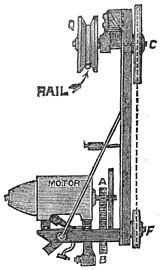ing, driving-wheels, etc. The locomotive is suspended by two wheels, Q, which have rubber tires. The electrical current passing through the motor drives it at the rate of sixteen hundred to  Fig. 3.-Tandem Locomotive
Fig. 3.-Tandem Locomotive
(end view). seventeen hundred revolutions a minute, and the power is transmitted by the cog-wheels A and B to a second horizontal shaft on which is a chain-wheel, F. A chain going round this wheel, and round two chain-wheels at C, C, causes the two driving-wheels of the locomotive to rotate.
Various forms of grip and friction-gearing locomotives have been devised by the staff of the Telpherage Company, but it was found that the simple locomotive represented in the figure could go quite readily up inclines as steep as one foot rise in thirteen; no grades so steep as this were needed at Glynde, hence the more elaborate machines were not put in use there. Prof. Perry is confident that the simple locomotive would be effective on grades as steep as one in ten, if the rail be kept quite dry. It was found that the weight of the locomotive, which is not much greater than that of one of the loaded skeps, with the aid of the rubber tires produces enough friction on the rail for the propulsion of the train. In the wet season of the year the rubber tires will last only a fortnight, but in dry weather their life is much longer. Still, even on the wettest days the locomotive performs its work quite well.
It was feared at first that trains near the engine-house would move much faster than those which were farther away. But this difficulty is prevented by an electrical governor attached to each locomotive. In Fig. 4, D is the second shaft, and W' W' are the two weights of a centrifugal governor, which are held ordinarily in position near the axis by means of the spring S. When the weights fly apart to the dotted positions W' and W', they draw the lever into the dotted position and break the metallic contacts at c, so that no electricity can be received by the motor. But no spark is made at c, because, after the contact is broken there, a connection of small resistance is continued for a short time at a, between two carbons, or a piece of carbon and a piece of iron, one of which is compelled by a spring to follow the other for some distance. If the contact be suddenly broken when the motor is making seventeen hundred revolutions a minute, the electric current will remain cut off until the speed of the motor has become reduced to about fifteen hundred. The position of the governor on the
